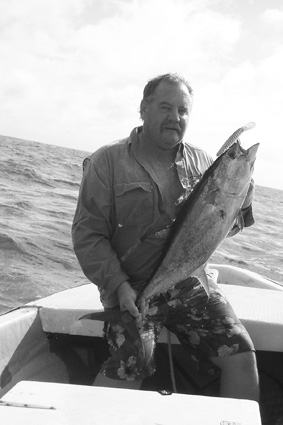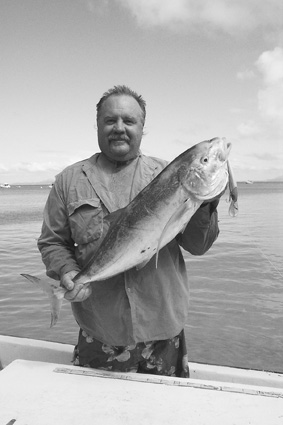A little nip in the air and the fish have been responding accordingly.
June is the start of Central Queensland’s cold month or so that usually triggers many of the local species into breeding. Huge schools of mack tuna and northern blues have made their way into the area and have provided a good distraction for anglers searching for a feed. We often follow mack tuna and throw metal slugs to score the odd mackerel or trevally. The commotion that the tuna cause as they attack bait schools attracts plenty of doggies that feed on the scraps and fleeing bait.
Out near The Keppels on the Yeppoon side we have a patch of rubble with a couple of bommies called The Forty Acre Paddock. This little spot is a fish magnet for most of the pelagic species and plenty of bottom dwellers. Whether you’re chasing doggies, spotted, Spanish mackerel, mack tuna or northern blues this is a great starting point. The proximity to Yeppoon makes Forty Acre an easy place to look for livebaits on the way out wide too. Many times in the last few years we have ended up with a variety of quality fish without having to head out any further. This was the first location we noticed mackerel and trevally under the tuna.
If you want to catch the tuna, red and white feather jigs and white marabou jigs work as well as anything. Tuna like small and fast lures better, so slow down and wait for the lure to sink. Mackerel and trevally prefer something shiny.
Normally when chasing doggies we use a light to mid-weight Flasha lures about 60mm long. When targeting mackerel that are hanging under the tuna increase the weight of the lure so it goes deeper. Sometimes tuna will take a crack at the lure on the freefall, but mackerel usually grab the Flasha as it flutters between the crowds of hungry fish. This method tends to empty the tackle box because lures taken on the drop get swallowed more often than lures that are jigged.
Wire leaders only get about a quarter of the hits that the lures on mono leaders do. The new hard clear leaders certainly help and there are less bite offs. We often target mackerel instead of tuna but that doesn’t mean that the odd tuna isn’t worth taking home for the table.
Northern blues make a welcome addition to the BBQ while mack tuna isn’t quite as good. If you do take some mack tuna home make sure you blanch it in hot water first. They both make great bait on the reefs.
Last month I received a couple of emails asking how to cook northern blues, so I will give you a rough outline once again.
The trick with a blue is to bleed it well on capture, fillet, skin the fish and cut out the darker bloodline areas (put these aside for bait).
Cut up the fillet into pieces about 100mm long, 50mm wide and 10mm thick. Make a marinade from soy and tomato sauce with a spoon full of brown sugar and some lemon juice. This is more of a dipping marinade rather than soaking the fish in the marinade for too long.
Heat the barbie to fairly hot before putting the fish on. Turn it when the bottom side goes brown and as soon as you can pass a skewer through the fillet without it grabbing, take it off the plate and serve.
Northern blue will never compare to our top of the shelf fish, but it does make a great BBQ finger food.
Greys and doggies will be about in numbers and are well worth hunting in the bay and around the islands. This year’s average fish have been larger than previous runs, and until recently the biggest catches were out at the shoals and the wider islands.
As the weather and the water clarity has improved in the bay the lesser mackerels came on in force. Spanish mackerel have been consistent in close with the larger quantities showing along the contour lines out behind the islands and heading north. This time last year we caught some top Spaniards at The Pinnacles, Flat and Perforated. The really big fish will be at Cape Manifold and Double Rocks.
For the better part of the year we get a raw deal as far as the wind goes except for June when the wide grounds cop lots of attention. Planned trips have a good chance of being successful and there are stacks of decent fish that will satisfy most of us.
Grunter, one of this region’s most popular fish, will again dominate night captures north of Yeppoon at places like The Pinnacles and Cape Manifold. In the south Cave Isle and Cape Capricorn both have reasonable grunter beds. The runs of grunter aren’t as regular as they used to be so sometimes they are a bit hit and miss. If you follow the weather and miss out on grunter then big black jew should fill the gap.
Grunter will be caught on two main rig types including the usual snapper rig (paternoster) or a running sinker down to the hook. When the fish are a bit finicky a smaller sinker on the hook floated down can make the difference. Squid, pilchards and prawns are larger offshore grunter favourite foods.
Black jew hang in the same areas as grunter and were in full swing in April. Reports of fine jewies in the 10-15kg class were common. Whilst they may not be as large as they get, these jew fight like their bigger brothers. The onshore jew holes come into their own in winter because of the proximity to the boat ramps and when conditions allow almost any size boat is big enough to reach them.
The other specials for June are whiting and dart on the beaches, red emperor, red jew and coral trout outside. Providing the water temperatures drop snapper might be on the menu, if not this month then next. Make the most of the cooler weather and enjoy it while you can.
Reads: 3609
A northern blue tuna caught on a cheap $3 lure with beefed up hooks.

A bludger trevally by name not by nature caught underneath a tuna school.




